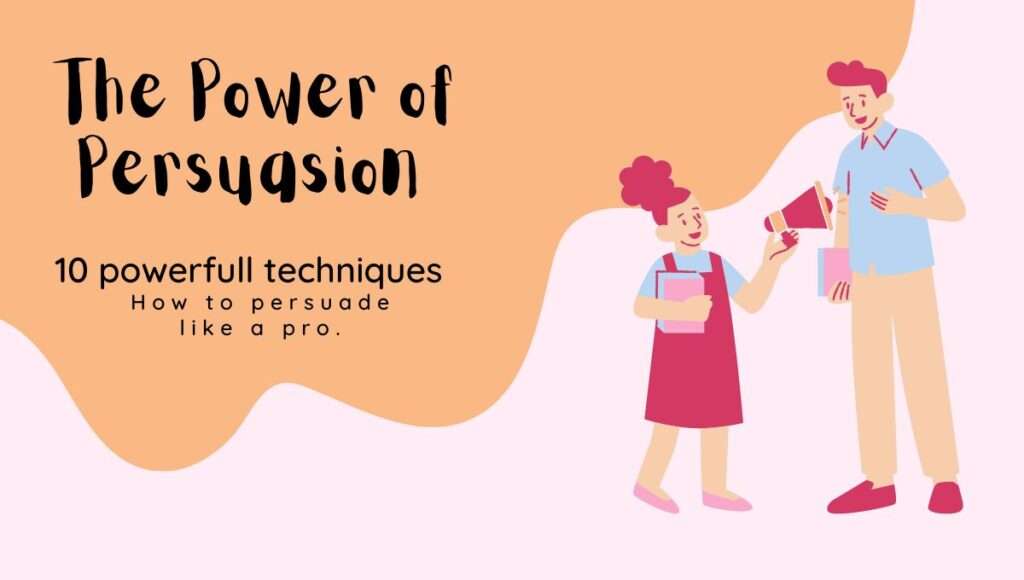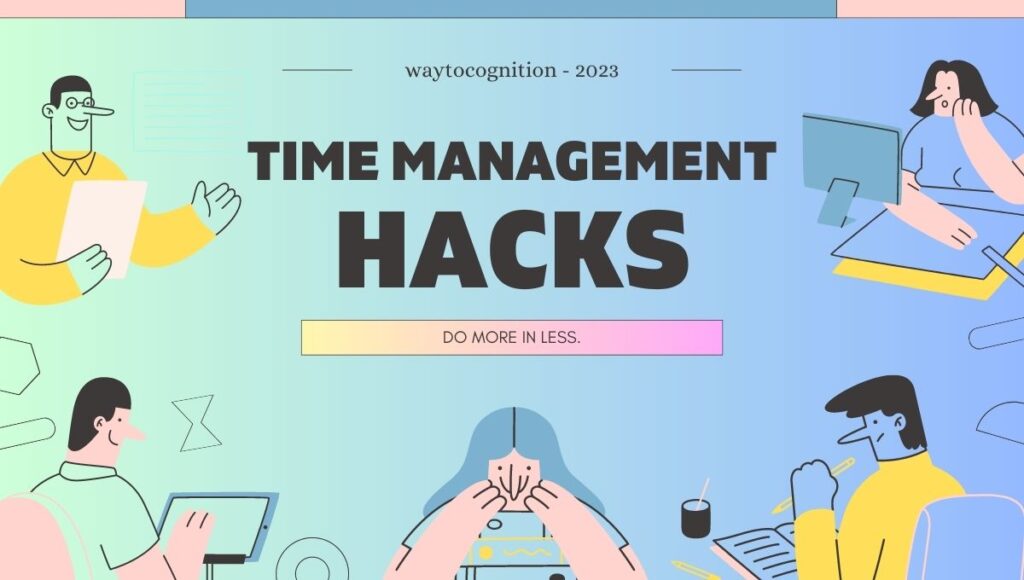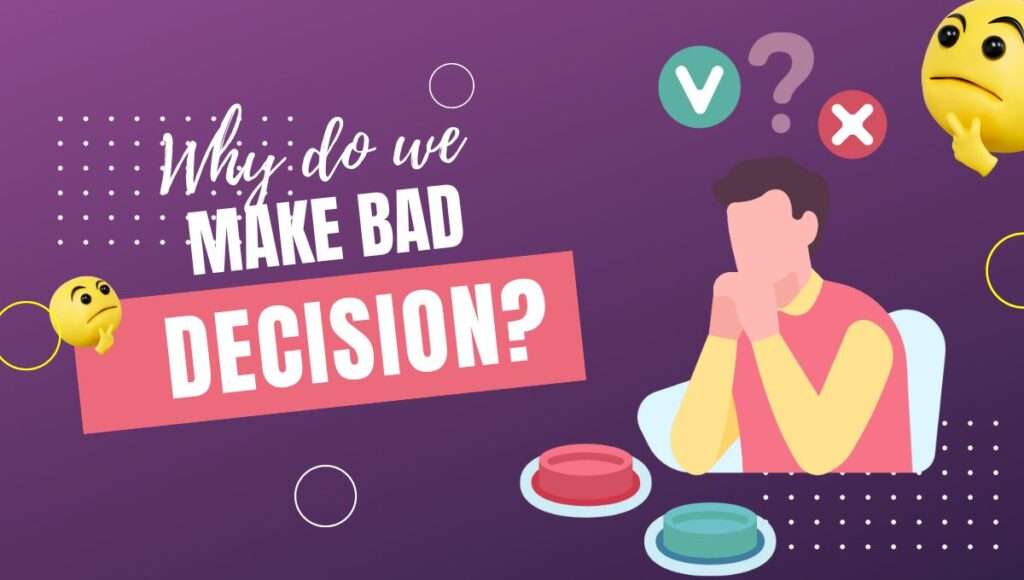The Power of Persuasion: 10 Persuasion Techniques That Will Make You a Great Communicator.

Do you want to be more influential and persuasive in your personal and professional life? Do you want to learn how to get others to agree with you, support you, or follow you? Do you want to improve your communication skills and build better relationships?
If you answered yes to any of these questions, then this blog post is for you. 😊
Persuasion is the art of influencing others to adopt a certain belief, attitude, or action. It is a skill that can help you achieve your goals, solve problems, and create positive change. Persuasion is not about manipulating or coercing others, but about understanding their needs, motivations, and emotions, and presenting your ideas in a way that appeals to them.
Persuasion is an essential skill for personal and professional success. Being persuasive can help you:
- Build trust, rapport, and credibility with others
- Resolve conflicts and negotiate win-win outcomes
- Motivate and inspire others to take action
- Sell your products, services, or ideas more effectively
- Lead and manage teams more efficiently
- Enhance your reputation and authority in your field
- Increase your confidence and self-esteem
In this blog post, I will share with you 10 persuasion techniques that can help anyone become a great communicator. These techniques are based on the principles of psychology, neuroscience, and social science, and have been proven to work in various situations. By applying these techniques, you will be able to persuade others with ease and grace, and achieve your desired results.
Are you ready to discover the power of persuasion? Let’s get started! 🚀
Persuasion Technique 1: Reciprocity

Have you ever felt obliged to return a favor or repay a debt? If so, then you have experienced the principle of reciprocity. Reciprocity is the tendency of people to feel indebted to those who have done something nice or helpful for them, and to return the gesture in kind.
Reciprocity is a powerful persuasion technique because it creates a sense of obligation and gratitude in the other person. By offering something valuable, useful, or helpful to the other person, you can increase their likelihood of agreeing to your request or doing something for you in return.
Some examples of how to use reciprocity in persuasion are:
- Giving a free sample, trial, or bonus to your potential customers
- Sending a thank-you note, gift, or compliment to your clients or colleagues
- Sharing valuable information, advice, or resources with your audience or network
- Volunteering your time, skills, or expertise to a cause or organization that matters to the other person
- Doing something unexpected or extra for the other person that goes beyond their expectations
Some tips on how to use reciprocity effectively are:
- Be genuine and sincere. Don’t offer something with the sole intention of getting something back. Offer something that you genuinely think will benefit the other person and that matches their needs and interests.
- Be timely and proportional. Don’t wait too long to offer something or ask for something in return. Offer something as soon as possible after establishing a relationship with the other person, and ask for something that is reasonable and appropriate for what you have offered.
- Be specific and clear. Don’t leave the other person guessing what you want from them or what they can do for you. Make your request or suggestion explicit and easy to understand. Explain how it will benefit both parties and why it is important.
Technique 2: Scarcity

Have you ever wanted something more because it was rare, limited, or exclusive? If so, then you have experienced the principle of scarcity. Scarcity is the perception that something is valuable because it is scarce or hard to get.
Scarcity is a powerful persuasion technique because it creates a sense of urgency, fear of missing out (FOMO), and desire in the other person. By creating a scarcity of your product, service, or idea, you can increase its perceived value and demand, and make the other person more eager to act on it.
Some examples of how to use scarcity in persuasion are:
- Creating a limited-time offer or deadline for your product or service
- Highlighting the uniqueness or exclusivity of your product or service
- Emphasizing the potential loss or missed opportunity if the other person does not act on your offer
- Showing how many people have already bought or signed up for your product or service
- Using words or phrases that imply scarcity, such as “only”, “last chance”, “before it’s gone”, “limited edition”, “one-of-a-kind”, etc.
Some tips on how to use scarcity effectively are:
- Be honest and realistic. Don’t lie about the availability or quality of your product or service. Don’t create artificial scarcity that can backfire or damage your reputation. Be truthful and transparent about what you are offering and why it is scarce.
- Be specific and relevant. Don’t use vague or generic statements that can be ignored or dismissed. Use concrete numbers, dates, or facts that can demonstrate the scarcity of your offer. Use relevant examples or testimonials that can show the value and benefits of your offer.
- Be logical and reasonable. Don’t use scare tactics or pressure tactics that can alienate or offend the other person. Don’t make unrealistic or exaggerated claims that can undermine your credibility. Use logical arguments and rational explanations that can persuade the other person to act on your offer.
Technique 3: Authority

Have you ever trusted or followed the opinions or recommendations of experts, leaders, or credible sources? If so, then you have experienced the principle of authority. Authority is the tendency of people to respect and obey those who have expertise, knowledge, or power in a certain field or domain.
Authority is a powerful persuasion technique because it creates a sense of trust, confidence, and credibility in the other person. By displaying your authority or using the authority of others, you can increase your influence and persuade others to listen to you, believe you, or follow you.
Some examples of how to use authority in persuasion are:
- Displaying your credentials, qualifications, or achievements that show your expertise or experience in your field
- Citing relevant facts, statistics, or testimonials that support your claims or arguments
- Using endorsements from influential or respected figures that are related to your topic or niche
- Using symbols or signs of authority, such as titles, uniforms, logos, badges, etc.
- Using authoritative words or phrases, such as “according to”, “research shows”, “experts agree”, “proven”, “guaranteed”, etc.
Some tips on how to use authority effectively are:
- Be confident and humble. Don’t be arrogant or boastful about your authority. Don’t act superior or condescending to the other person. Be confident and assertive, but also humble and respectful.
- Be honest and ethical. Don’t misuse or abuse your authority. Don’t lie about your credentials or qualifications. Don’t use false or misleading information or sources. Be honest and ethical about your authority and how you use it.
- Be respectful and helpful. Don’t use your authority to intimidate or manipulate the other person. Don’t use your authority to impose your views or opinions on the other person. Use your authority to educate and inform the other person. Use your authority to help and serve the other person.
Technique 4: Consistency

Have you ever acted in ways that are consistent with your previous commitments, statements, or actions? If so, then you have experienced the principle of consistency. Consistency is the desire of people to be consistent with their self-image, values, and goals.
Consistency is a powerful persuasion technique because it creates a sense of commitment, alignment, and harmony in the other person. By getting the other person to make a small commitment or agreement with you, you can increase their likelihood of making a bigger one later on.
Some examples of how to use consistency in persuasion are:
- Asking for small favors or agreements before asking for bigger ones
- Reminding the other person of their values or goals that are related to your request or proposal
- Using the “foot-in-the-door” technique: asking for a small and easy request first, then asking for a larger and more difficult one later
- Using the “low-ball” technique: offering a low-cost or attractive deal first, then revealing additional costs or conditions later
Some tips on how to use consistency effectively are:
- Be clear and reasonable. Don’t confuse or overwhelm the other person with too many requests or options. Don’t ask for unreasonable or unrealistic commitments or agreements. Be clear and simple about what you want from the other person and why.
- Be flexible and respectful. Don’t force or pressure the other person to commit or agree with you. Don’t make them feel guilty or ashamed if they change their mind or refuse your request. Be flexible and respectful of their choices and preferences.
- Be supportive and appreciative. Don’t take the other person’s commitment or agreement for granted. Don’t neglect or ignore them after they have agreed with you. Be supportive and appreciative of their cooperation and collaboration.
Technique 5: Liking

Have you ever been more persuaded by those who you like, admire, or relate to? If so, then you have experienced the principle of liking. Liking is the preference of people for those who are similar to them, who compliment them, or who cooperate with them.
Liking is a powerful persuasion technique because it creates a sense of rapport, affinity, and attraction in the other person. By making yourself more likable and appealing to the other person, you can increase their receptivity and responsiveness to your ideas and suggestions.
Some examples of how to use liking in persuasion are:
- Finding common ground or interests with the other person
- Giving genuine compliments or praise to the other person
- Using humor or empathy to connect with the other person
- Using the principle of liking in persuasion, continued:
- Showing interest and attention to the other person
- Mirroring or matching the other person’s body language, tone, or style
- Sharing personal stories or experiences with the other person
Some tips on how to use liking effectively are:
- Be sincere and friendly. Don’t fake or exaggerate your liking for the other person. Don’t flatter or praise the other person for ulterior motives. Be sincere and friendly in your interactions and expressions.
- Be diverse and adaptable. Don’t assume that everyone likes the same things or has the same preferences. Don’t impose your views or opinions on the other person. Be diverse and adaptable to different people and situations.
- Be attentive and responsive. Don’t ignore or interrupt the other person. Don’t be distracted or bored by the other person. Be attentive and responsive to their needs, emotions, and feedback.
Technique 6: Social Proof

Have you ever followed the behavior or opinions of others who are similar to you or whom you trust? If so, then you have experienced the principle of social proof. Social proof is the tendency of people to conform to the norms or expectations of others, especially when they are uncertain or ambiguous.
Social proof is a powerful persuasion technique because it creates a sense of validation, conformity, and popularity in the other person. By showing that others have already done or approved what you are suggesting, you can increase the credibility and attractiveness of your offer or idea.
Some examples of how to use social proof in persuasion are:
- Showing testimonials or reviews from satisfied customers or clients
- Mentioning the popularity or demand of your product or service
- Using the “bandwagon” effect: implying that everyone is doing or buying what you are offering
- Using endorsements from celebrities, influencers, or experts that are relevant to your niche or audience
- Using words or phrases that imply social proof, such as “best-selling”, “most trusted”, “award-winning”, “recommended”, etc.
Some tips on how to use social proof effectively are:
- Be relevant and credible. Don’t use social proof that is irrelevant or outdated. Don’t use social proof that is fake or fabricated. Use social proof that is relevant and credible to your target audience and niche.
- Be diverse and specific. Don’t use social proof that is too general or vague. Don’t use social proof that is too similar or homogeneous. Use social proof that is diverse and specific to show the different aspects and benefits of your offer or idea.
- Be ethical and respectful. Don’t use social proof that is unethical or disrespectful. Don’t use social proof that is misleading or deceptive. Use social proof that is ethical and respectful to your audience and your competitors.
Technique 7: Contrast

Have you ever perceived things differently depending on what they are compared with? If so, then you have experienced the principle of contrast. Contrast is the effect of comparing two or more things that are different or opposite in some way.
Contrast is a powerful persuasion technique because it creates a sense of difference, comparison, and evaluation in the other person. By presenting your offer or idea as a better alternative than others, you can increase its perceived value and appeal, and make the other person more likely to choose it.
Some examples of how to use contrast in persuasion are:
- Presenting your offer or idea as a better alternative than others
- Highlighting the benefits or advantages of your solution over others
- Using the “door-in-the-face” technique: asking for a large and unreasonable request first, then asking for a smaller and more reasonable one later
- Using the “that’s-not-all” technique: adding more value or benefits to your offer or idea after presenting it
- Using words or phrases that imply contrast, such as “but”, “however”, “instead”, “on the other hand”, “compared to”, etc.
Some tips on how to use contrast effectively are:
- Be fair and realistic. Don’t use contrast that is unfair or unrealistic. Don’t compare apples and oranges. Don’t compare your offer or idea with something that is irrelevant or incomparable. Use contrast that is fair and realistic to your audience and niche.
- Be logical and reasonable. Don’t use contrast that is illogical or unreasonable. Don’t use false or misleading information or sources. Don’t use emotional or irrational appeals. Use contrast that is logical and reasonable to your audience and niche.
- Be respectful and ethical. Don’t use contrast that is disrespectful or unethical. Don’t use negative or derogatory language or tone. Don’t use personal attacks or insults. Use contrast that is respectful and ethical to your audience and niche.
Technique 8: Framing

Have you ever reacted differently depending on how information is presented or worded? If so, then you have experienced the principle of framing. Framing is the effect of presenting or wording information in different ways that can influence how people perceive and respond to it.
Framing is a powerful persuasion technique because it creates a sense of perspective, interpretation, and evaluation in the other person. By framing your offer or idea in a way that matches the other person’s needs, motivations, and emotions, you can increase its perceived relevance and attractiveness, and make the other person more likely to accept it.
Some examples of how to use framing in persuasion are:
- Using positive or negative framing depending on your goal: emphasizing gains or losses, benefits or costs, opportunities or risks, etc.
- Using emotional or rational appeals depending on your audience: using stories or facts, anecdotes or statistics, metaphors or logic, etc.
- Using simple or complex language depending on your context: using plain or technical terms, short or long sentences, simple or sophisticated vocabulary, etc.
Some tips on how to use framing effectively are:
- Be clear and consistent. Don’t confuse or contradict yourself with different frames. Don’t use frames that are unclear or ambiguous. Use frames that are clear and consistent with your message and goal.
- Be appropriate and relevant. Don’t use frames that are inappropriate or irrelevant to your audience or niche. Don’t use frames that are offensive or insensitive. Use frames that are appropriate and relevant to your audience and niche.
- Be creative and surprising. Don’t use frames that are boring or predictable. Don’t use frames that are common or cliché. Use frames that are creative and surprising to your audience and niche…
Technique 9: Commitment

Have you ever stuck to your decisions once you have made them publically or privately? If so, then you have experienced the principle of commitment. Commitment is the tendency of people to be consistent with their decisions, especially when they have invested time, effort, or resources in them.
Commitment is a powerful persuasion technique because it creates a sense of ownership, responsibility, and loyalty in the other person. By getting the other person to commit to your offer or idea, either verbally or in writing, you can increase their attachment and involvement, and make them more likely to follow through.
Some examples of how to use commitment in persuasion are:
- Asking the other person to write down their agreement, sign a contract, or make a verbal promise
- Using the “bait-and-switch” technique: offering a low-cost or attractive deal first, then changing the terms or conditions later
- Using the “that’s-not-all” technique: adding more value or benefits to your offer or idea after presenting it
- Using words or phrases that imply commitment, such as “promise”, “guarantee”, “pledge”, “commit”, etc.
Some tips on how to use commitment effectively are:
- Be respectful and ethical. Don’t force or pressure the other person to commit to your offer or idea. Don’t trick or deceive them with false or misleading information or promises. Be respectful and ethical in your interactions and agreements.
- Be supportive and helpful. Don’t abandon or neglect the other person after they have committed to your offer or idea. Don’t make them regret or resent their decision. Be supportive and helpful in their implementation and execution.
- Be appreciative and rewarding. Don’t take the other person’s commitment for granted. Don’t ignore or overlook their efforts or achievements. Be appreciative and rewarding of their cooperation and collaboration.
Technique 10: Collaboration

Have you ever been more persuaded when you felt you were part of a team or a shared goal? If so, then you have experienced the principle of collaboration. Collaboration is the willingness of people to work together towards a common objective or outcome.
Collaboration is a powerful persuasion technique because it creates a sense of belonging, contribution, and satisfaction in the other person. By involving the other person in the decision-making process, seeking their input or feedback, or creating a win-win situation, you can increase their engagement and motivation, and make them more likely to agree with you.
Some examples of how to use collaboration in persuasion are:
- Involving the other person in the decision-making process
- Seeking their input or feedback on your offer or idea
- Creating a win-win situation that benefits both parties
- Using words or phrases that imply collaboration, such as “together”, “team”, “partnership”, “cooperation”, etc.
Some tips on how to use collaboration effectively are:
- Be cooperative and open-minded. Don’t be competitive or stubborn with the other person. Don’t dismiss or reject their ideas or opinions. Be cooperative and open-minded in your interactions and discussions.
- Be attentive and responsive. Don’t ignore or interrupt the other person. Don’t be distracted or bored by their suggestions or comments. Be attentive and responsive to their needs, emotions, and feedback.
- Be appreciative and respectful. Don’t take the other person’s collaboration for granted. Don’t criticize or blame them for any mistakes or failures. Be appreciative and respectful of their efforts and achievements.
Conclusion

In this blog post, I have shared with you 10 persuasion techniques that can help anyone become a great communicator. These techniques are:
- Reciprocity: offering something valuable, useful, or helpful to the other person
- Scarcity: creating a sense of urgency, fear of missing out, and desire in the other person
- Authority: displaying your expertise, knowledge, or power in your field
- Consistency: getting the other person to make a small commitment or agreement with you
- Liking: making yourself more likable and appealing to the other person
- Social proof: showing that others have already done or approved what you are suggesting
- Contrast: presenting your offer or idea as a better alternative than others
- Framing: presenting or wording information in different ways that influence how people perceive and respond to it
- Commitment: getting the other person to commit to your offer or idea, either verbally or in writing
- Collaboration: involving the other person in the decision-making process, seeking their input or feedback, or creating a win-win situation
By applying these techniques, you will be able to persuade others with ease and grace, and achieve your desired results.
Persuasion is a skill that can be learned and improved with practice and feedback. I hope that this blog post has given you some useful tips and insights on how to master persuasion and become a great communicator.
Thank you for reading this blog post. I hope you found it useful and informative. 😊
If you have any questions, comments, or feedback, please feel free to share them with me. I would love to hear from you and learn from you.
If you enjoyed this blog post and want to learn more about personal development, please subscribe to my blog, follow me on social media, or check out my other resources for more tips and insights.
I wish you all the best in your personal and professional endeavors. Remember, you have the power of persuasion. Use it wisely and ethically. 🙏
FAQs
How can I avoid being manipulated or coerced by others who use persuasion techniques on me?
You can avoid being manipulated or coerced by others who use persuasion techniques on you by being aware of their tactics, being critical of their claims, and being assertive of your rights and preferences. You can also seek a second opinion, do your own research, or walk away from the situation if you feel uncomfortable or pressured.
How can I improve my persuasion skills and become a better communicator?
You can improve your persuasion skills and become a better communicator by practicing and applying the techniques that I have shared with you in this blog post. You can also read more books, articles, or blogs on persuasion and communication, watch videos or podcasts of persuasive speakers or communicators, or take courses or workshops on persuasion and communication.
How can I measure the effectiveness of my persuasion techniques and the results of my communication?
You can measure the effectiveness of your persuasion techniques and the results of your communication by setting clear and specific goals, tracking and analyzing your progress and outcomes, and seeking feedback from others. You can also use tools or methods such as surveys, polls, quizzes, tests, or experiments to evaluate your persuasion and communication skills and performance.
How can I balance the ethical and moral aspects of persuasion and communication?
You can balance the ethical and moral aspects of persuasion and communication by following some basic principles, such as honesty, respect, empathy, responsibility, and integrity. You can also adhere to the codes of conduct or standards of practice of your profession or industry, respect the rights and interests of others, and avoid harming or exploiting others.
How can I adapt my persuasion techniques and communication style to different audiences, situations, and contexts?
You can adapt your persuasion techniques and communication style to different audiences, situations, and contexts by doing some research and preparation before you communicate, understanding the needs, motivations, and emotions of your audience, using appropriate language, tone, and format for your message, and being flexible and responsive to feedback and changes.



